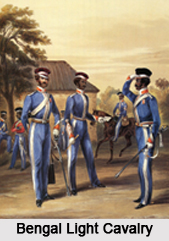 Bengal Cavalry was a part of the Bengal Army of the Bengal Presidency, an administrative province existing during British rule in India. The cavalry comprised of the Regular Regiments and the Irregular Units. Given below are some of the Regular Regiments and the Irregular Units of the Bengal Cavalry.
Bengal Cavalry was a part of the Bengal Army of the Bengal Presidency, an administrative province existing during British rule in India. The cavalry comprised of the Regular Regiments and the Irregular Units. Given below are some of the Regular Regiments and the Irregular Units of the Bengal Cavalry.
Regular Regiments of Bengal Cavalry
Regular Regiments comprised of the Governor General`s Bodyguard, 1st to 10th Bengal Light Cavalry Regiments (eight of which mutinied and two were disbanded during 1857- 1858) and 1st to 4th Bengal European Light Cavalry Regiments (which were created urgently in Britain in November, 1857 as replacements of the eight regiments of Bengal Light Cavalry which had mutinied). Some of the Regular Regiments are described below.
Governor General"s Bodyguard
Governor General`s Bodyguard, a cavalry regiment of the British Indian Army was functional from 1773 to 1950. The unit participated in the Egyptian campaign in 1801, in the campaign to seize Java in the Dutch East Indies (now Indonesia) from the Dutch, First Burmese War, Gwalior War of 1843, etc.
3rd Bengal Light Cavalry
3rd Bengal Light Cavalry under the East India Company`s Bengal Army was created in 1797. This regiment urged to mutiny in April, 1857 due to the imprisonment of 85 of its members. It forwarded to Delhi and its arrival lead to what is known as the "Indian Mutiny". This regiment was later disbanded.
5th Bengal Light Cavalry
5th Bengal Light Cavalry under the British East India Company is known to serve in the occupation of Kabul in 1841. A part of the regiment acted as rearguard in the disastrous "retreat from Kabul", where it was annihilated. The rest served through the defense of Jellalabad under Sale. It later served in the Cabul Campaign of 1842 and in both Anglo-Sikh Wars.
1st Bengal European Light Cavalry
1st Bengal European Light Cavalry was a cavalry regiment which existed from the year 1857 to 1922. The regiment was a part of the Sudan expedition from 1884 to 1885, fought at Tel el Kebir, took part in the Siege of Ladysmith in the South African War, etc. Later it was re-designated as the 19th Hussars.
4th Bengal European Cavalry
4th Bengal European Cavalry under the British East India Company was a cavalry regiment created in 1858 with the aim to serve during the Indian Mutiny. It was dissolved in 1859.
Irregular Units of Bengal Cavalry
Some of the Irregular Units of Bengal Cavalry were 1st Irregular Cavalry (Skinner`s Horse), 2nd to 18th Irregular Cavalry Regiments, 2nd Gwalior Cavalry, Bengal Yeomanry Cavalry and Barrow`s Volunteers.






































